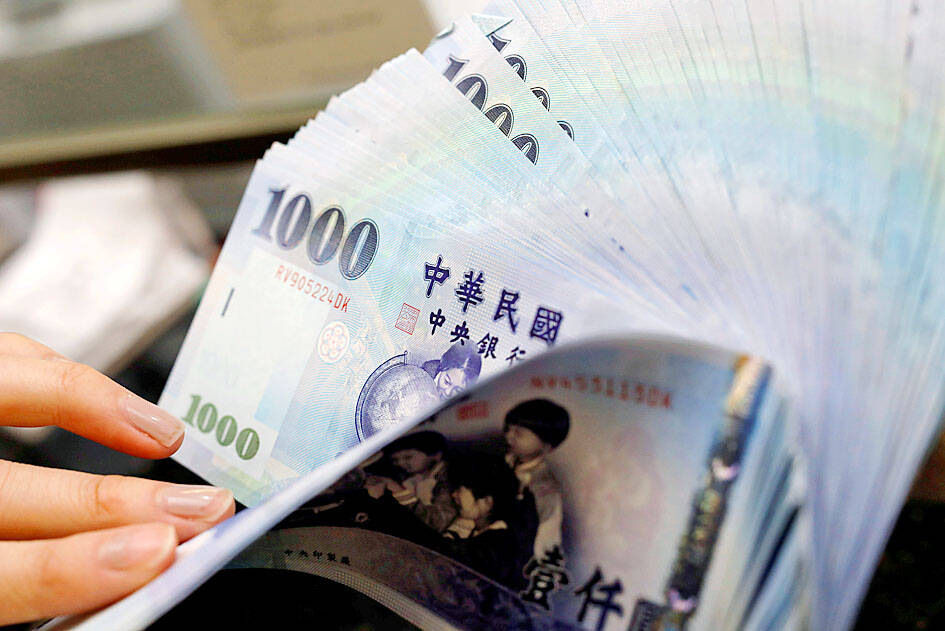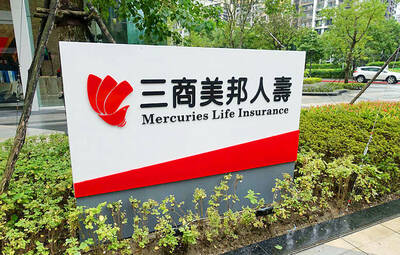The New Taiwan dollar is on the verge of overtaking the yuan as Asia’s best carry-trade target given its lower risk of interest-rate and currency volatility.
A strategy of borrowing the New Taiwan dollar to invest in higher-yielding alternatives has generated the second-highest return over the past month among Asian currencies behind the yuan, based on the Sharpe ratio that measures risk-adjusted relative returns.
The New Taiwan dollar may soon replace its Chinese peer as the region’s favored carry trade tool, analysts say, citing Beijing’s efforts to support the yuan that can create wild swings in borrowing costs. In contrast, Taiwan’s central bank can afford to be more relaxed as any weakness in the local currency ends up benefiting the export-driven economy and can attract artificial intelligence-led capital flows into local stocks.

Photo: Reuters
“The Taiwan dollar has been one of the better funding currencies in Asia along with the offshore yuan, but with recent intervention risks in the yuan placing bigger chances of a short squeeze, Taiwan dollar becomes much more attractive,” Bloomberg Intelligence chief Asia foreign-exchange and rates strategist Stephen Chiu (趙志軒) said.
Elsewhere in Asia, the yen is facing a cycle of interest-rate hikes, while other potential funding currencies are either more expensive to short or have higher volatility, Chiu said.
The yuan’s appeal as a funding source for carry trades is weakening as the People’s Bank of China steps up its currency defense ahead of anticipated tariff hikes under the second term of US president-elect Donald Trump. The Chinese central bank’s measures, ranging from setting an artificially strong reference exchange to draining liquidity and verbal warnings, have turned the offshore yuan into Asia’s third-most volatile currency in the past month.
Meanwhile, the New Taiwan dollar is starting to look even more attractive as a funding source after weakening beyond what was seen as a key psychological level of 33 per US dollar for the first time in about nine years on Monday.
The New Taiwan dollar is poised to decline further, along with its regional peers, with Trump’s return to the White House accentuating risks from more challenging trade dynamics to a less dovish US Federal Reserve, HSBC Holdings PLC Asia foreign-exchange research head Joey Chew (周淑芬) said.
“Nevertheless, with fundamentals robust, Taiwan’s economy is relatively well placed to ride through this near-term volatility,” with a lower risk for aggressive currency intervention from the central bank, Chew said.

Mercuries Life Insurance Co (三商美邦人壽) shares surged to a seven-month high this week after local media reported that E.Sun Financial Holding Co (玉山金控) had outbid CTBC Financial Holding Co (中信金控) in the financially strained insurer’s ongoing sale process. Shares of the mid-sized life insurer climbed 5.8 percent this week to NT$6.72, extending a nearly 18 percent rally over the past month, as investors bet on the likelihood of an impending takeover. The final round of bidding closed on Thursday, marking a critical step in the 32-year-old insurer’s search for a buyer after years of struggling to meet capital adequacy requirements. Local media reports

AI BOOST: Although Taiwan’s reliance on Chinese rare earth elements is limited, it could face indirect impacts from supply issues and price volatility, an economist said DBS Bank Ltd (星展銀行) has sharply raised its forecast for Taiwan’s economic growth this year to 5.6 percent, citing stronger-than-expected exports and investment linked to artificial intelligence (AI), as it said that the current momentum could peak soon. The acceleration of the global AI race has fueled a surge in Taiwan’s AI-related capital spending and exports of information and communications technology (ICT) products, which have been key drivers of growth this year. “We have revised our GDP forecast for Taiwan upward to 5.6 percent from 4 percent, an upgrade that mainly reflects stronger-than-expected AI-related exports and investment in the third

TECHNOLOGICAL RIVALRY: The artificial intelligence chip competition among multiple players would likely intensify over the next two years, a Quanta official said Quanta Computer Inc (廣達), which makes servers and laptops on a contract basis, yesterday said its shipments of artificial intelligence (AI) servers powered by Nvidia Corp’s GB300 chips have increased steadily since last month, should surpass those of the GB200 models this quarter. The production of GB300 servers has gone much more smoothly than that of the GB200, with shipments projected to increase sharply next month, Quanta executive vice president Mike Yang (楊麒令) said on the sidelines of a technology forum in Taipei. While orders for GB200 servers gradually decrease, the production transition between the two server models has been

US sports leagues rushed to get in on the multi-billion US dollar bonanza of legalized betting, but the arrest of an National Basketball Association (NBA) coach and player in two sprawling US federal investigations show the potential cost of partnering with the gambling industry. Portland Trail Blazers coach Chauncey Billups, a former Detroit Pistons star and an NBA Hall of Famer, was arrested for his alleged role in rigged illegal poker games that prosecutors say were tied to Mafia crime families. Miami Heat guard Terry Rozier was charged with manipulating his play for the benefit of bettors and former NBA player and